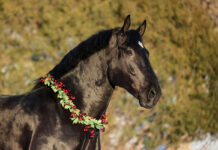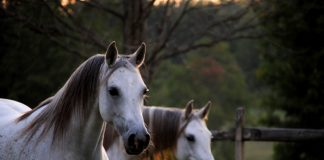
Mangalarga Marchador
Once in Brazil, the king continued his breeding program, and appointed a Portuguese horse breeder named St. João Francisco Junqueira to cross the Alter Real stallions with Barb mares that had been imported from Africa. One of the results of these crossings was a stallion named Sublime.
Sublime was owned by the king’s son, Prince Pedro I, who would later become the emperor of Brazil. Owner of the Hacienda Camp Alegre Farm, a respected breeding operation, Pedro I crossed Sublime with Barb and Spanish Jennet mares, and some believe with Criollos and Andalusians as well. The resulting horses, called Sublime horses, were fast and had smooth gaits. They also had incredible stamina and were good mounts for long excursions.
When a breeding operation called Hacienda Mangalarga purchased Sublime horses and began producing them in large numbers, the breed underwent a change of name. In the 1930s, Marchador was added to the name to distinguish the horse from a related breed known as the Mangalarga Paulista, developed by breeders who crossed the Mangalarga with the Thoroughbred, Arabian and Standardbred.
Although the Mangalarga Marchador became the national horse of Brazil, it was relatively unknown in the United States until the late 1990s. First imported to Florida, the Marchador remained virtually unknown in America. This changed when the Mangalarga Marchador Horse Association of America was formed in 2000. More horses were imported, and a marketing campaign was launched to raise awareness in the United States.
While Marchadors are plentiful in Brazil, they are still considered a rare breed in the United States. Fewer than 200 registered Marchadors can be found in North America.
Although the Mangalarga Marchador is one of several South American gaited horses, the breed is truly unique when compared to its gaited cousins. Marchadors are born with the ability to perform the marcha picada and the marcha batida. The marcha picada is a four-beat lateral gait. The gaiting sequence of the marcha picada requires the right rear hoof to touch the ground first, then the right front hoof, the left rear hoof and the front left hoof. Because the horse always has three feet on the ground at any given moment and the hind feet over-reach the front feet, the resulting gait is very smooth.
As the Marchador performs the marcha picada, his front end becomes elevated. Marchadors can maintain the gait for long periods of time at significant speed.
The marcha batida differs from the marcha picada in that it is a four-beat diagonal gait. Although the marcha batida appears similar to a trot, one foot is always on the ground at any given time, whereas the trot places the horse completely in the air at one point during the sequence. Marchadors performing the marcha batida look as if they are cantering in the front and trotting in the back.
Marchador owners in the United States are using these horses in a variety of disciplines, including pleasure riding, endurance, competitive trail, ranch and cattle work, mounted shooting, mounted archery, reining, dressage and roping.
Mangalarga Marchador Characteristics
Body: The withers are well-defined, and the chest is broad and muscular. A medium-length back leads to a long, well-muscled croup that is slightly slanted. The mane and tail are sparse and silky.
Head & Neck: The head is triangular in shape with a broad, flat forehead. The large eyes are expressive and set wide apart. The ears are medium-sized with the tips pointing slightly inward.
Height: Between 14.2 and 16 hands.
Liked this article? Here are others you’ll enjoy:
Mangalarga Marchador Breed Profile
Meeting the Mangalarga Marchador
Riding the Mangalarga Marchador
Video: Mangalarga Marchador
Back to Latin American Horse Breeds >>
This article originally appeared in the July 2011 issue of Horse Illustrated. Click here to subscribe!






Such a cool breed with such a cool name.